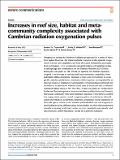Increases in reef size, habitat and metacommunity complexity associated with Cambrian radiation oxygenation pulses
Date
06/12/2022Metadata
Show full item recordAbstract
Oxygenation during the Cambrian Radiation progressed via a series of short-lived pulses. However, the metazoan biotic response to this episodic oxygenation has not been quantified, nor have the causal evolutionary processes been constrained. Here we present ecological analyses of Cambrian archaeocyath sponge reef communities on the Siberian Platform (525–514 Ma). During the oxic pulse at ~521–519 Ma, we quantify reef habitat expansion coupled to an increase in reef size and metacommunity complexity, from individual within-community reactions to their local environment, to ecologically complex synchronous community-wide response, accompanied by an increase in rates of origination. Subsequently, reef and archaeocyath body size are reduced in association with increased rates of extinction due to inferred expanded marine anoxia (~519–516.5 Ma). A later oxic pulse at ~515 Ma shows further reef habitat expansion, increased archaeocyath body size and diversity, but weaker community-wide environmental responses. These metrics confirm that oxygenation events created temporary pulses of evolutionary diversification and enhanced ecosystem complexity, potentially via the expansion of habitable space, and increased archaeocyath individual and reef longevity in turn leading to niche differentiation. Most notably, we show that progression towards increasing biodiversity and ecosystem complexity was episodic and discontinuous, rather than linear, during the Cambrian Radiation.
Citation
Zhuravlev , A Y , Mitchell , E G , Bowyer , F , Wood , R & Penny , A 2022 , ' Increases in reef size, habitat and metacommunity complexity associated with Cambrian radiation oxygenation pulses ' , Nature Communications , vol. 13 , 7523 . https://doi.org/10.1038/s41467-022-35283-5
Publication
Nature Communications
Status
Peer reviewed
ISSN
2041-1723Type
Journal article
Description
Funding: This work was funded by UKRI grant NE/S014756/1 (E.G.M.) and Project NE/T008458/1 (R.W. and F.B.).Collections
Items in the St Andrews Research Repository are protected by copyright, with all rights reserved, unless otherwise indicated.

